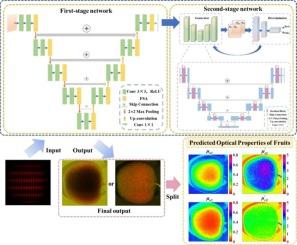一种UNet-GAN两阶段网络,用于从单幅多频图像中快速准确地预测苹果的光学特性
IF 8.9
1区 农林科学
Q1 AGRICULTURE, MULTIDISCIPLINARY
引用次数: 0
摘要
空间频域成像(SFDI)是一种非侵入性光学成像技术,广泛应用于水果组织光学特性的定量测定,特别是吸收系数(μa)和降散射系数(μs’)。然而,传统的SFDI方法依赖于多个频率和相位图像,限制了实时成像能力。为了解决这一问题,我们提出了一种基于两阶段深度神经网络架构的新型快速预测方法,称为FSGOP(频率-空间注意UNet和基于gan的两阶段光学特性预测网络)。与传统的三相解调SFDI相比,该方法的采集时间缩短了约5/6,推理时间仅为0.21 s。在第一阶段,采用频率-空间注意(FSA)增强的UNet网络对多频分量进行有效解耦。在第二阶段,利用生成对抗网络(GAN)预测光学性质,从而实现从单幅多频混合条纹图像中同时提取不同频率条件下的μa和μs映射。在苹果、梨和桃子的实验中,该方法对μs '的标准化平均绝对误差分别为0.10 (f1)和0.09 (f2),对μa的标准化平均绝对误差分别为0.07和0.06。结果显示,不同频率下的光学性质图中存在显著的互补信息,较低频率对亚表面损伤更敏感,而较高频率更有效地揭示表面纹理特征。该方法提高了多频成像的信息利用率和实时性,为农产品光学特性提取和质量检测提供了快速、准确、低成本的解决方案。本文章由计算机程序翻译,如有差异,请以英文原文为准。

A UNet-GAN two-stage network for rapid and accurate prediction of apple optical properties from single multi-frequency images
Spatial frequency domain imaging (SFDI) is a non-invasive optical imaging technique widely used for the quantitative determination of fruit tissue optical properties, specifically absorption coefficient (μa) and reduced scattering coefficient (μs’). However, traditional SFDI methods rely on multiple frequency and phase images, limiting real-time imaging capabilities. To address this issue, we present a novel rapid prediction method based on a two-stage deep neural network architecture, termed FSGOP (Frequency-Spatial Attention UNet and GAN-based two-stage network for optical properties prediction). Compared with conventional three-phase demodulation SFDI, this method reduces the acquisition time by approximately 5/6 and requires only 0.21 s for inference. In the first stage, a UNet network enhanced by Frequency-Spatial Attention (FSA) is employed to effectively decouple the multi-frequency components. In the second stage, a Generative Adversarial Network (GAN) is utilized to predict the optical properties, thereby enabling the simultaneous extraction of μa and μs’ maps under different frequency conditions from a single multi-frequency mixed fringe image. In experiments on apples, pears, and peaches, the method yielded normalized mean absolute errors of 0.10 (f1) and 0.09 (f2) for μs’, and 0.07 and 0.06 for μa, respectively. The results revealed significant complementary information in the optical property maps at different frequencies, with lower frequencies being more sensitive to subsurface damage and higher frequencies revealing surface texture features more effectively. This method enhances information utilization and real-time performance in multi-frequency imaging, offering a rapid, accurate, and low-cost solution for optical property extraction and quality inspection of agricultural products.
求助全文
通过发布文献求助,成功后即可免费获取论文全文。
去求助
来源期刊

Computers and Electronics in Agriculture
工程技术-计算机:跨学科应用
CiteScore
15.30
自引率
14.50%
发文量
800
审稿时长
62 days
期刊介绍:
Computers and Electronics in Agriculture provides international coverage of advancements in computer hardware, software, electronic instrumentation, and control systems applied to agricultural challenges. Encompassing agronomy, horticulture, forestry, aquaculture, and animal farming, the journal publishes original papers, reviews, and applications notes. It explores the use of computers and electronics in plant or animal agricultural production, covering topics like agricultural soils, water, pests, controlled environments, and waste. The scope extends to on-farm post-harvest operations and relevant technologies, including artificial intelligence, sensors, machine vision, robotics, networking, and simulation modeling. Its companion journal, Smart Agricultural Technology, continues the focus on smart applications in production agriculture.
 求助内容:
求助内容: 应助结果提醒方式:
应助结果提醒方式:


